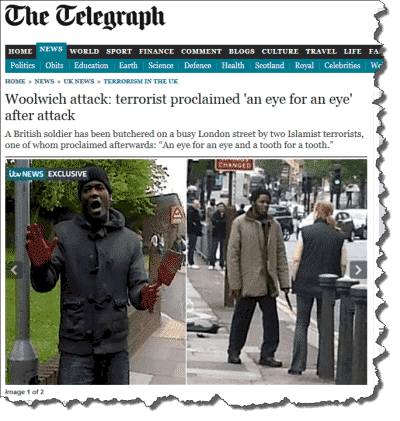 The horrendous attack of a soldier in Woolwich was undeniably barbaric. We can only imagine what his poor family must be going through; sudden death is always difficult to cope with, but even more so in such a terrible public way. Also, we must wonder about the parents of the young man photographed with blood on his hands, almost celebrating the fact that the soldier was killed. I wonder how his mother feels today. Yesterday she was probably thinking that her son was just out on a shopping trip; the next thing she sees is a video of him admitting to having hacked a defenceless man to death.
The horrendous attack of a soldier in Woolwich was undeniably barbaric. We can only imagine what his poor family must be going through; sudden death is always difficult to cope with, but even more so in such a terrible public way. Also, we must wonder about the parents of the young man photographed with blood on his hands, almost celebrating the fact that the soldier was killed. I wonder how his mother feels today. Yesterday she was probably thinking that her son was just out on a shopping trip; the next thing she sees is a video of him admitting to having hacked a defenceless man to death.
Events like this affect many people; the witnesses are unlikely to ever forget what they saw. Some may well suffer from post traumatic stress disorder. One man was killed in an horrific way, but dozens of others will suffer psychologically for many years to come. There are many other victims.
The online world may also contribute to the victim count. Hundreds of thousands of people have already watched the graphic videos online that the TV channels have clearly decided not to rebroadcast. But with the vast increase in “citizen journalism” and the spread of user generated content, the public at large can no longer be protected from the horrors of the world.
Yet what is interesting to consider is the spread of such horrible videos and images. If the material is so dreadful, why do people share it?
Researchers at the University of Alabama have discovered why. It is a phenomenon known as “emotional contagion”. Essentially, we want to share things – negative or positive – that have affected us deeply. It is the same reason why people share funny videos or titillating ones for that matter. Online content goes viral because it affects us.
So, even though we may be horrified by the events we should not be too concerned about the sharing of those dreadful videos of the butchery that took place in South Easy London yesterday. Indeed, the very fact that they are being shared is testament to the fact that we are deeply affected by them. It demonstrates the true horror we all feel about what happened.

2 thoughts on “Woolwich videos go viral – but why?”
I am interested in your view that the sharing of these horrible graphic images demonstrates the emotional horror we all feel. I cannot think of a worse way of caring than indulging in self centred voleurism.
I did not know the man. I am saddened to think he died in such a wanton murderous attack but I cannot grieve for someone I didn’t know. That agony is for those who loved and cared for him and whose loss cannot be eased by sentimental outpourings and gratuitous image sharing from complete strangers.
Thanks for your comment Charlotte. I agree that the voyeurism is dreadful and as I said in the blog post the whole sordid affair was agonising for the loved ones involved and for the witnesses. I did not say, however, that the image sharing was any kind of positive thing. All I said was that it is a reflection of our emotions. The research is quite clear – indeed our behaviour has always been thus. When we are deeply affected by something we want to share it with others. The online sharing of these dreadful images and videos is merely a reflection of our distaste because people have been deeply affected. If the images were not being shared it would actually show we do not care.
Comments are closed.